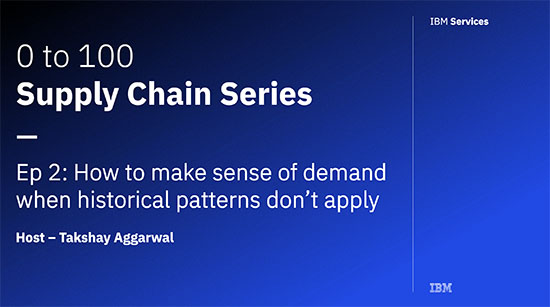Smarter Strategies
Insights and best practices for digital transformation
How IBM Helped a Global Food Distribution Company Fix its Supply Chain, and Better See the Future
By Jorge Malibrán Ángel, Strategy Consulting, IBM
The COVID-19 pandemic exposed fragilities in supply chains all over the world, and few industries were hit harder than food distribution.
Early last spring—as the severity and likely duration of the pandemic became clear—supermarkets across the U.S. found their shelves barren as people stocked up heavily on critical goods. At the same time, other distribution channels—like restaurants or school cafeterias—saw demand evaporate, and suddenly had far more merchandise than they could use.
One major global distributor in the space saw its supply chain upturned, and realized it needed better intelligence, and quickly. So the company turned to IBM to help it improve its forecasting, foresee bottlenecks, and adapt to unpredictable crises.
Using data and AI to achieve end-to-end visibility
Typically, when a company forecasts demand it relies on internal historical data, often assuming the same volume as the prior year, give-or-take five percent. That system may work in “normal” years, but when unexpected disruptions happen, companies have little or no historical data as a guide, and suddenly find themselves operating in the dark.
Another problem: These forecasts tend to be static, and can’t adjust as new information becomes available, and thus can quickly become obsolete.
Using demand sensing from IBM’s Continuous Intelligent Planning solution, the company was able to leverage a much broader array of data inputs and massively broaden its vision.
In addition to a company’s historical sales, IBM’s solution analyzes data from a wide and diverse array of sources like upcoming events, existing inventory, government actions, macroeconomic conditions, and the weather. And IBM’s AI turned the complex data sets into actionable intelligence, offering a rolling forecast up to 72 weeks out.
The company suddenly had a richly detailed and dynamic view of its ecosystem, and within four weeks of implementation, the client told IBM it had never had this level of visibility. It could see on a national scale where it was vulnerable to undersupply because of spikes in the demand, and where decreased demand would leave markets oversupplied.
IBM’s system also revealed new opportunities. For example: the system predicted that demand would spike in channels that were not traditionally large parts of the company’s footprint: e-commerce, “club” outlets like Costco, and “value” outlets like Dollar General. With the added foresight, merchandise that was packed for bulk sales could be unbundled and sold to smaller outlets—or the opposite—if the demand landscape shifted.
 With IBM’s AI and data collection, the company is much better able to withstand unpredicted shocks than before. It better understands its current inventory, can forecast much more accurately, and will be better able to seize new opportunities as they arise.
With IBM’s AI and data collection, the company is much better able to withstand unpredicted shocks than before. It better understands its current inventory, can forecast much more accurately, and will be better able to seize new opportunities as they arise.
For a longer discussion of how IBM technology can offer end-to-end visibility to make supply chains more agile and resilient, please listen to the latest podcast, “0 to 100 Supply Chain Series: How to make sense of demand when historical patterns don’t apply.”